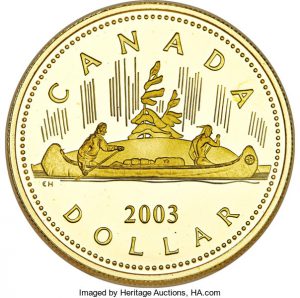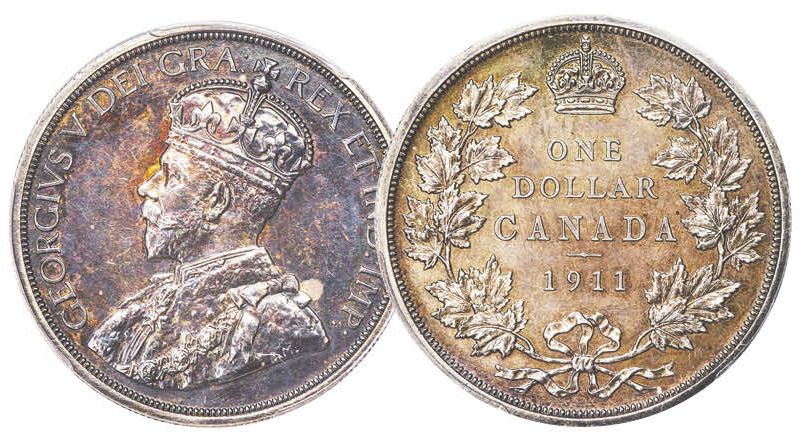By Jesse Robitaille
Prices include buyer’s premium.
“We waited to see what the action was in the room; there are a lot of games you can play.”
The pair now has a plan to keep the coin on Canadian territory.
“It’s never leaving Canada again,” said dealer Sandy Campbell, owner of Proof Positive Coins, who added he and Ian Laing, owner of Gatewest Coin, will announce more details soon.
“It’s Canadian cultural property; it should’ve never been outside of the country in the first place in my opinion. It was sort of a fine line as to whether it could’ve even been auctioned down there, but it all worked out in the end. It’s coming back to Canada.”
“We will find a home for it in Canada,” said Laing, who echoed Campbell’s comments, adding, “It will not leave Canada again.”
“It does belong here; it’s been in and out of Canada two or three times in its numismatic history, which started way back in the 1960s, but this time it’s going to stay.”
Now graded by Professional Coin Grading Service (PCGS) as Specimen-64, the coin was previously certified as PCGS Specimen-65 and sold in 2003 for $690,000 US as part of the Belzberg Collection.
The only other 1911 silver dollar has been held in the Bank of Canada’s National Currency Collection – on loan from the British Royal Mint – since the 1970s.
The duo believed the example offered this August would bring upwards of $2 million, Campbell said, adding, “That’s what we planned to pay for the coin.”
“The stars aligned. There’s so much controversy about Cook cleaning his coins – he damaged a lot of coins – but the ’11 dollar remained untouched but people ruled it out because of that. We had a tumultuous week in the stock market and that didn’t help.”
In general, however, “the auction was quite strong,” said Campbell, who’s currently managing the fixed-price sale of the Cornerstone Collection, two-thirds of which has sold and realized $3 million.
“This Cook auction was much stronger than the quality would’ve dictated going into the auction; unfortunately, a lot of coins were cleaned, but there were still great coins in the auction.”

The 2003 Proof ‘Golden Jubilee’ $1 coin – a unique piece – in PCGS Proof-67 Deep Cameo realized $108,000 US as Lot 31383.
‘COULD’VE BEEN MUCH, MUCH WORSE’
The main portion of the Cook Collection brought $3.2 million US (about $4.2 million Cdn.) when it crossed the block on Aug. 15.
It was billed by Heritage Auctions as the world’s most complete collection of Canadian coins, and all 439 lots sold to bidders from Canada and beyond; however, concerns about the collection’s cleaned coins – namely how many, and which ones – were the focus of discussions before, during and after the sale.
“It did affect the results,” said Cris Bierrenbach, vice-president of international numismatics at Heritage Auctions, “and obviously, for the coins that he did clean, the prices were clearly affected.”
Among the coins, most of which were certified by Professional Coin Grading Service (PCGS), about 30 lots were re-certified with either “cleaned,” “repaired,” “altered surfaces,” “surfaces smoothed” or “questionable colour” designations and given no numerical grade.
A 1905 specimen half-dollar, for example, was offered as Lot 31299 in PCGS Uncirculated Details with an “altered surfaces” designation. It brought $3,360 US (about $4,475 Cdn.).
“He paid $50,000 for it,” said Bierrenbach.
Another downgraded example was an 1884 Victoria specimen cent – the only known specimen example – formerly graded Specimen-65 Red Brown by Numismatic Guaranty Corp. It brought $55,812.50 as Lot 30028 of the 2014 sale of the Eric P. Newman Collection.
This August, however, that same coin – now in PCGS Uncirculated Details with a “cleaned” designation – brought only $6,600 US (about $8,800 Cdn.).
“It’s a good lesson for anyone who wants to touch coins,” said Bierrenbach, who simply advises collectors not to touch their coins.
“The most important thing is don’t touch your coin. If you buy a coin and for whatever reason, you don’t like the way it looks – it’s too dark, too bright, too red or too green – and you want to possibly conserve it, never do anything to the coin before asking a professional.”
He suggests contacting a third-party grading service to ask if there’s anything to do to improve the way a coin looks.
“The majority of the time, they’ll say there’s nothing that can be done,” said Bierrenbach, who added if Cook submitted some of the coins now brandished with a “cleaned” designation, the grading service would’ve advised “there’s nothing to be done.”
“Leave them as is, as many people told him during his life,” added Bierrenbach, who worked with Cook for more than a decade to help build his Canadian set.
“But it’s not that bad because for the good coins, the grades were kept the same; the vast majority were untouched. It could’ve been much, much worse obviously,” he said, adding he’s seen cleaned collections “more often than we should.”
“Overall, we were extremely happy with the results. The family was very happy, and we achieved results over our highest expectations.”
With dozens of bidders vying for some lots, there was enough bidding to throw the auction off schedule by 45 minutes.
“The action across the board was something I haven’t seen in 12 years of doing auctions at Heritage,” said Bierrenbach, who added he has “never been late to a session” before the Cook auction.
The second portion of the Cook Collection will be offered in an online sale on Aug. 25, three days after this issue of CCN goes to print. A brief review will be published in the following issue.
Additional group lots of “low-value material” will be offered in one of Heritage Auctions’ gallery sales later this year, Bierrenbach added.
SPECIMEN ‘DOT’ CENT
Other highlights of the Cook Collection include the finest of only three known 1936 specimen “dot” cents, this in PCGS Specimen-65 Red and Brown.
It brought $312,000 US (about $415,000 Cdn.) as Lot 31048.
The example in the Cook Collection was previously offered as part of the Canadiana Collection in 2010, when it was certified as Specimen-66 Red by PCGS and sold for $402,000 US.
Before that, it brought $230,000 US in 2003 – and in the same grade – as part of the sale of the Belzberg Collection.
1921 HALF-DOLLARS, 1916-C SOVEREIGN
Cook’s collection also included specimen and business strikes of the rare 1921 half-dollar, known as “The King of Canadian Coins.”
One example in PCGS Mint State-66 realized $240,000 US (about $320,000 Cdn.) as Lot 31317.
Another example, this in Mint State-63, brought $120,000 US (about $160 Cdn.) as Lot 31318.
A 1916-C gold sovereign in PCGS Mint State-66 – tied for the finest certified example – also brought $156,000 US (about $207,000 Cdn.) as Lot 31390.
CANADA’S RAREST DOLLAR
A unique Canadian gold dollar, the 2003 Proof “Golden Jubilee” $1 coin in PCGS Proof-67 Deep Cameo, realized $108,000 US (about $143,000 Cdn.) as Lot 31383.
The commemorative coin was struck by the Royal Canadian Mint to celebrate the 50th anniversary of the Coronation of Queen Elizabeth II. Produced to raise money for charity, the Mint used the dies for the 2003 special-edition silver dollar to strike only one example – the example offered as part of the Cook Collection – in gold.

